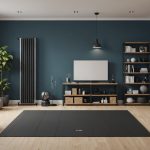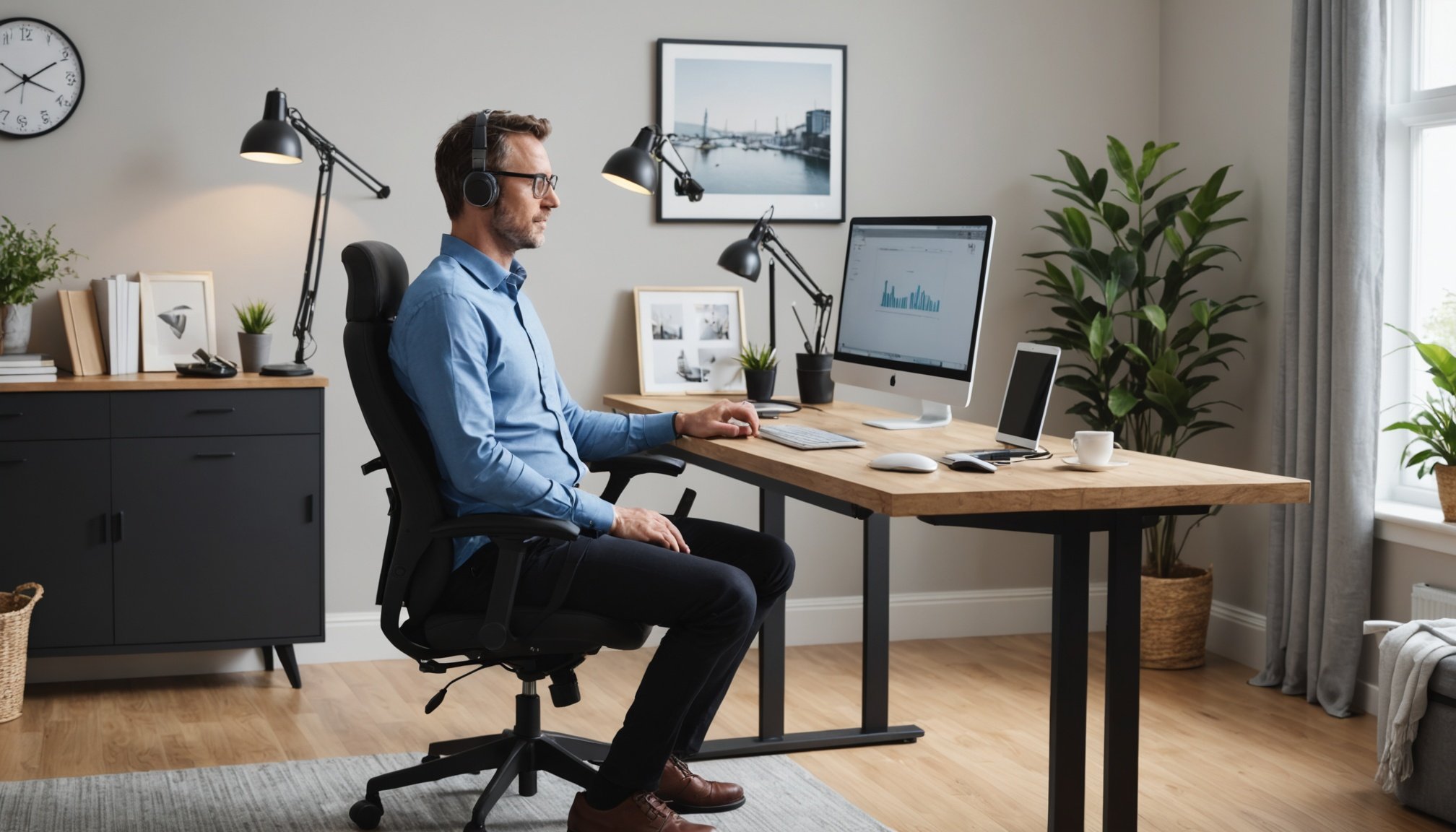Transform Your Work-from-Home Setup: Essential Tips for UK Adults to Enhance Posture and Boost Comfort
As the world continues to embrace the flexibility of working from home, it’s crucial to ensure that your home office setup is not only functional but also supportive of your health and wellbeing. Here’s a comprehensive guide to help you create an optimal work-from-home environment that enhances your posture, boosts your comfort, and improves your overall work experience.
Understanding the Importance of a Well-Designed Home Office
Working from home can be a blessing, but it can also lead to a range of health issues if not managed properly. For instance, prolonged sitting, poor posture, and inadequate workspace design can all take a toll on your physical and mental health.
In the same genre : Boost Your UK Diet: Creative Ways to Add More Whole Foods to Your Plate
” Sitting still for extended periods when working, whether at home or in the office, is no good for your lower back and in particular, it allows a sustained stretch on the ligaments to deform them,” warns Michael Fatica, a consultant osteopath for The Back in Shape Program.
To avoid these issues, it’s essential to invest time and effort into designing a home office that supports your health and wellbeing.
In parallel : Designing a Compact and Impactful Home Fitness Routine for UK Residents with Space Constraints
Choosing the Right Desk for Your Home Office
The desk is the centerpiece of any home office, and selecting the right one can make a significant difference in your comfort and posture.
Standing Desks: A Game-Changer for Health
Standing desks, or sit-stand desks, are highly recommended for those who spend a lot of time working from home. These desks allow you to switch between sitting and standing throughout the day, which is crucial for maintaining good posture and overall health.
According to the NHS, standing desks can help break up long periods of sitting, which is linked to a slower metabolism and other health issues. Here are some key benefits of using a standing desk:
- Improves Posture: Standing while working helps maintain a better posture compared to sitting for long hours.
- Reduces Back Pain: By alternating between sitting and standing, you reduce the pressure on your spine and lower back.
- Boosts Metabolism: Standing can help increase your metabolism, which can aid in weight management and overall health.
Key Features to Consider When Buying a Standing Desk
When selecting a standing desk, here are some features to keep in mind:
| Feature | Description |
|---|---|
| Workspace Size | Ensure the desk is large enough to fit your laptop, keyboard, and other essentials. A width of at least 120cm is recommended for two monitors. |
| Height Range | Choose a desk with an adjustable height range to accommodate both sitting and standing comfortably. |
| Load Capacity | Make sure the desk can handle the weight of all your work essentials. |
| Ease of Use | Opt for a desk with easy-to-use mechanisms for switching between sitting and standing positions. |
| Additional Features | Consider desks with built-in cable management, ergonomic design, and durability. |
Setting Up Your Home Office Space
Beyond the desk, the overall setup of your home office is crucial for comfort and productivity.
Utilizing Natural Light
Natural light can significantly enhance your work environment. Here are some tips to maximize natural light in your home office:
- Position Your Desk Near a Window: Placing your desk near a window not only provides natural light but also offers a pleasant view, which can boost your mood and productivity.
- Use Interior Windows: If possible, use interior windows to allow light to flow through different spaces in your home, creating a more illuminated and peaceful setting.
Creating a Dedicated Workspace
Having a dedicated workspace is essential for maintaining a healthy work-life balance. Here are some ideas to create an effective home office:
- Bedroom Office: If you don’t have a spare room, consider converting a corner of your bedroom into an office. Use a Murphy bed or a vertical screen to separate the workspace from the sleeping area.
- Cloffice: A cloffice is a closet converted into a workspace. This can be a great option for small homes, providing a quiet and focused area for work.
- Attic Office: If you have an attic, consider transforming it into a cozy office. This can offer a quiet and secluded space that is perfect for focused work.
Ergonomic Tips for Better Posture and Comfort
Maintaining good posture and comfort while working from home requires attention to several ergonomic factors.
Chair and Seating
Your chair is as important as your desk. Here are some tips for choosing the right chair:
- Ergonomic Design: Look for a chair with an ergonomic design that supports your back and promotes good posture.
- Adjustable Height: Ensure the chair has an adjustable height to fit your desk and body comfortably.
- Cushioning and Support: Opt for a chair with adequate cushioning and lumbar support to reduce back pain and discomfort.
Monitor and Keyboard Placement
The placement of your monitor and keyboard can significantly impact your posture.
- Monitor Height: Place your monitor at eye level or slightly below to avoid straining your neck.
- Keyboard Position: Keep your keyboard directly in front of you, with your wrists straight and your elbows at a 90-degree angle.
Additional Tips for Enhancing Comfort and Productivity
Here are some additional tips to enhance your comfort and productivity while working from home:
Flexible Scheduling
One of the main benefits of working from home is the flexibility it offers. Here are some ways to make the most of it:
- Flexible Hours: Adjust your work hours to fit your most productive times of the day.
- Breaks: Take regular breaks to stretch, move around, and rest your eyes.
Reducing Stress and Improving Mental Health
Working from home can sometimes blur the lines between work and personal life, leading to stress and mental health issues. Here are some tips to help:
- Separate Workspace: Maintain a separate workspace to help you distinguish between work and personal time.
- Connect with Your Team: Regularly connect with your team members to avoid feelings of isolation and to maintain a sense of community.
Practical Benefits of Working from Home
Here are some practical benefits of working from home that can enhance your overall wellbeing:
- Improved Work-Life Balance: Working from home allows you to manage your family and personal responsibilities more effectively.
- Reduced Commute: Avoiding the daily commute can save time, reduce stress, and improve your overall health.
Creating an optimal home office setup is not just about functionality; it’s also about ensuring your health and wellbeing. By choosing the right desk, setting up a dedicated workspace, and following ergonomic tips, you can significantly enhance your posture, comfort, and productivity.
Remember, “78% of those who worked from home in some capacity said that being able to work from home gave them an improved work-life balance,” and “47% of workers recorded improved wellbeing from working from home in some capacity”.
Investing in your home office is an investment in your health and happiness. Make sure to take the time to design a space that supports your body, mind, and work experience.
Detailed Bullet Point List: Benefits of Working from Home
Here are the key benefits of working from home, as reported by various studies:
- Flexible Scheduling: According to 50% of respondents, flexible scheduling is one of the main benefits of working from home.
- Lack of Commute: 43% of respondents appreciate the lack of commute, which saves time and reduces stress.
- Family Care: 34% find that working from home allows them to look after family, pets, ageing or unwell relatives better.
- Savings: 33% love the savings that working from home brings, including reduced travel costs and other expenses.
- Reduced Anxiety/Stress: 32% of respondents reported reduced anxiety and stress due to working from home.
- Improved Health: 25% cited improved health, whether it’s mental, physical, or spiritual.
- Reduced Office Politics: 19% state that working from home gives them the freedom from office politics.
- Freedom to Travel/Relocate: 18% appreciate the freedom to travel or relocate entirely while working from home.
Comprehensive Table: Comparing Standing Desks
Here is a comparative table of some popular standing desks, highlighting their key features:
| Desk Model | Workspace Size | Height Range | Load Capacity | Ease of Use | Additional Features |
|---|---|---|---|---|---|
| Yo-Yo Desk | 60cm (width) | Adjustable | 20kg | Easy to raise, difficult to lower | Separate adjustable sections for laptop and keyboard, gas spring mechanism |
| Varidesk ProPlus | 120cm (width) | Adjustable | 35kg | Easy to use | Built-in cable management, ergonomic design |
| Stand Steady | 80cm (width) | Adjustable | 25kg | Easy to use | Compact design, suitable for small spaces |
| Fully Jarvis | 120cm (width) | Adjustable | 35kg | Easy to use | Customizable height settings, durable construction |
By following these tips and investing in the right equipment, you can transform your work-from-home setup into a comfortable, productive, and healthy environment that supports your overall wellbeing.











